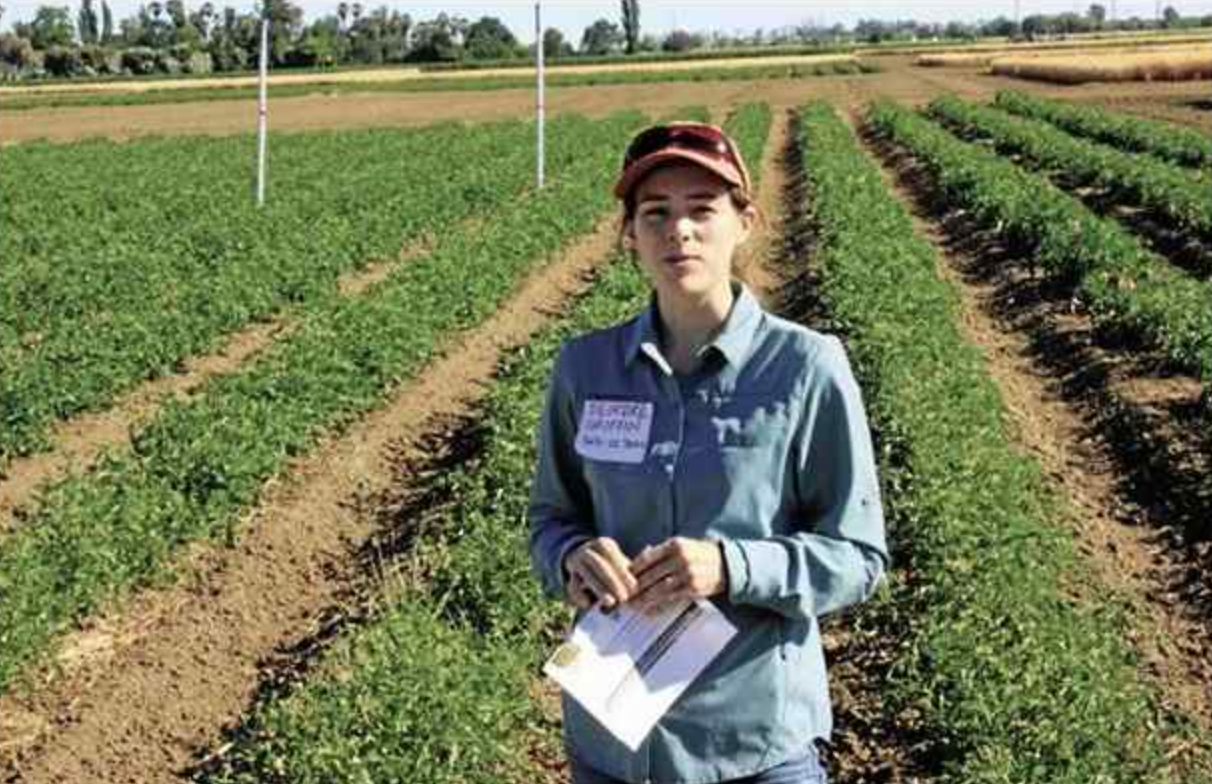The subsurface drip irrigation systems that have enhanced water use efficiency and increased yields in processing tomatoes may also have long-term effects on soil life that are worth monitoring.
Because drip emitters running down the center of the bed beneath the ground target irrigation delivery to the plants with precision, they may also leave important living organisms near the edges without a source of water. “Subsurface drip is used on 80 percent of the processing tomatoes in California,” said Deirdre Griffin, UC Davis, soil chemist. “It reduces weed pressure and reduces water use. The question is, what is happening with the soil that is only getting water half the year? It is worth paying attention to what may be happening to the soil over time.” Griffin discussed ongoing studies of the long-term impact of subsurface drip in tomatoes with the growers and researchers at Russell Ranch Field Day 2018: Increasing Farm Resilience through Healthy Soils and Water Management. Subsurface drip took the processing tomato sector by storm because the savings in hand weeding and water costs make it a winner at the bottom line. “The furrow used more than twice as much water as the drip, but the drip-irrigated organic plots had 13 percent lower yields than the furrow-irrigated organic plots,” Griffin said.
“Despite the higher yields, the profit was actually much lower in the furrow system because of all the hand weeding,” she said. The hidden issue with long-term use of buried drip is that it may starve microorganisms that are essential to the ability of the soil to cycle nutrients, sequester carbon, and absorb and store water. “We found less microbial activity near the edges of the bed with drip,” Griffin said. “We also found the drip-irrigated plots were getting slightly less aggregation, which could create problems for soil health in the long term.”
The widespread adoption of buried drip has had a major positive impact, according to a recently completed study of the processing tomato sector’s environmental footprint commissioned by a pasta sauce company. “Barilla was interested in an assessment of the impacts of sourcing and processing the tomatoes they get from California,” said Sonja Brodt, academic coordinator at the UC Davis Sustainable Agriculture Research and Education Program.
Researchers compared changes over the course of a decade in a range of detailed environmental impacts of practices in the greenhouses that supply the transplants, the fields where they are grown and the plants where they are processed. “We found some major farm improvements from 2005 to 2015,” Brodt said. “Half the respondents switched from furrow to drip during this time, and there was a 47- to 55-ton yield bump.”
The drip systems saved on water and reduced other important environmental impacts, especially when measured in terms of the cost of producing a ton of tomatoes. “There was a 40 percent increase in water-use efficiency,” Brodt said. “The biggest impacts were from the use of diesel, the natural gas in the processing facility, and your irrigation water. Diesel use increased 4 percent per acre, but went down 23 percent per ton. The production and use of diesel fuel is the main source of acidification and eutrophication. It went down per ton because of the yield bump.”
Researchers took a close look at whether running two buried drip lines down the bed rather than one would solve the issues of reduced soil microbial life and lower organic yields, but it didn’t. “The double lines of drip did not do much to the yield drop,” said Amelie Gaudin, UC Davis agroecologist. “The microbial impact is worth more study. This is just the tip of the iceberg, and we are going to look more at how irrigation affects the microbial community.”

Amelie Gaudin, a UC Davis agroecologist, has been studying the differences between furrow-irrigated and drip-irrigated tomato plants. Bob Johnson — Ag Alert |
Tomato plants on buried drip have far smaller roots, which could have long-term implications for soil health, as well as short-term effects on the yields of organic plants that take up their nutrients from the soil. “There are 35 percent more roots in the furrow-irrigated plants,” Gaudin said. “Drip-irrigated plants have less roots. They are smaller roots, and they are concentrated near the drip line. Most of the roots are in the top 12 inches. The roots take up water and nutrients, anchor the plant, and help with the soil structure and stability. We found there is more carbon cycling in furrow-irrigated plants, but more mycorrhizae in drip.”
One option that may be studied is running furrow irrigation a time or two during the season in fields with drip in order to bring the edges of the beds back to life. Another solution might be in the development of varieties that are specifically tailored for drip irrigation systems with few or no chemical inputs. “We have been breeding plants for high input systems for 50 years, and maybe they are not equipped to actively cycle carbon and nitrogen,” Gaudin said. “Do we need new varieties? Are our plants bred for systems with high inputs and furrow irrigation, but not drip?”
Reprinted with permission from AG Alert, the weekly newspaper of the California Farm Bureau

































